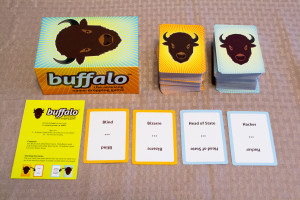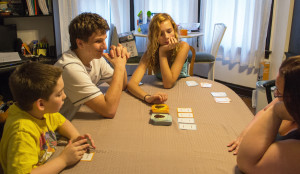When I first laid eyes on this particular game, I had trouble envisioning just what was inside the box. Did modern-day technology advance to the point where they can shrink herds of buffalo and put them inside a small box? Is this some odd variant of “Pass The Pigs”? Thankfully, it turned out to be neither, despite how badly I wanted miniature buffalo to go stampeding through my living room. “Buffalo”, in this case, takes on the role of a verb meaning, “to outwit, puzzle, or baffle”. It’s a card game designed for two to eight players, meant to be played by older children and adults. Before we get started checking out this game in further detail, I’d like to thank Amanda Young from Tiltfactor for providing me with a free review copy.
Components
Cards – The game comes with a blue deck and an orange deck, each containing two hundred and sixteen cards. Both decks contain descriptors (called word cards) like “male” and “cartoon character”, as well as buffalo cards that help players score on tough cards that they can’t match up. More on that in a moment.
Setup & Gameplay
Both decks are shuffled and placed face down on the table near each other. It’s important to mention in the here and now that there are no player turns in this game. When two cards are drawn, everyone will be rushing to come up with an answer before someone else does. To signal the start of the game, a card from each deck is drawn and placed face up near their respective decks.
After the first two cards are drawn, players will be attempting to make a match with the cards by calling out a fictional character or a real life person. The first person to do so (successfully) gets to place them into their personal score pile. If players can’t match and/or there is one card or less on the table, two more cards are drawn (one from each deck). When it comes to matching cards, players can link more than two cards together if they are able to do so.
While there are over two hundred word cards in each deck, buffalo cards will occasionally pop up. The first person to make a match while a buffalo card is on the table gets to take ALL of the face up cards, even if they remain unmatched. Once the decks run out, players will count their score piles and the person with the most cards, wins.
The above doesn’t cover all of the rules found in the manual, but should give you an idea as to how the game is played. For more information, you can check out the manual here:
http://www.tiltfactor.org/wp-content/uploads2/buffalo_rules.pdf
The Review
The manual is only one page long and the rules are laid out in a way that made learning the game easy to understand. The cards themselves were on the bland side, but I honestly found them easier to read that way. The box isn’t as large as say, “Apples to Apples”, making it ideal for travel and vacations. The box could stand to be a tad taller, as the cards were spilling over across the insert. In the grand scheme of things however, I had no complaints with the components or how everything was laid out.
I’ll say this, “Buffalo” gave us a good mental workout. It goes without saying that this isn’t necessarily a bad thing. Despite being gamers, the boys and I have significantly different tastes in hobbies. This goes double for the women of the household, as both Carolyn (14) and Jennifer often watch and listen to things that I can’t stomach. This game actually served to bring all of these different interests together, as we each were naming off people that some of us knew nothing about. In a way, it was an educational look at the pop culture and world events that we each grew up with.
While the rules tasked us with laying these cards out on the table, we found ourselves just sitting around the dining room table and calling out word cards after our initial review session was over. We’d pick two cards at random and just see if any of us could match them, without the step of keeping score. This casual gameplay variant ended up being just as fun as the core game and I could personally see it being a great ice-breaker at parties.
Speaking of variants, the manual includes a “repetition” and a “pro” variant, giving players a different way to stretch their minds. Repetition forbids players from using the same name twice, while the pro variant forces players to match all of the cards on the table to acquire visible buffalo cards. The game is flexible enough to where you could come up with your own variants, for those of you who enjoy doing such things. For example, folks could force players to match three or more cards instead of two or more cards. This might make for a more difficult game, but you get the idea.
In the end, “Buffalo” doubles as both an excellent mind teaser and a superb party game. While there is only one word descriptor per card, the chance that two cards would ever be dealt at the same time from one game to the next is pretty low. Vinnie (12) had a difficult time with this particular game and this is a rare case where I’d recommend that parents pay attention to the 14+ age recommendation. Both Jennifer and Carolyn (14) liked the game, but disliked the competitive tendencies that it could bring out in those who play strictly for points.
The price tag of $19.00, I feel, is just about on target. Card games like “Say Anything”, “5 Second Rule”, and “Last Word” all go for around twenty bucks, give or take. With that said, is “Buffalo” worth checking out? Most definitely. Is it right for you? That depends. Is your group overly competitive? Do you have a lot of younger kids in your family that join you on family game night? Do tempers flare easily where points are concerned? If the answer is yes to any of those questions, then you may want to consider an alternative, more cooperative game. Otherwise, “Buffalo” is just what the doctor ordered.
Final Verdict: 8/10
—
You can learn more about and purchase the game by visiting the following websites:
http://www.tiltfactor.org/buffalo
http://boardgamegeek.com/boardgame/127505/buffalo
—


